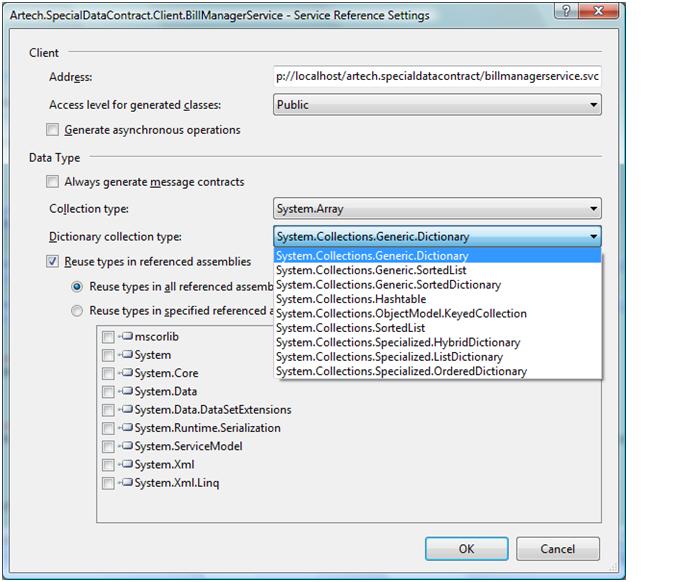Data Contract for Collection
我们照例用例子来说明问题,在这里我们创建一个批量处理Order的Service,于是我们创建了一个OrderCollection Type:
 namespace
Artech.SpecialDataContract.Contract
namespace
Artech.SpecialDataContract.Contract

 {
{ [DataContract]
[DataContract] public class Order
public class Order

 {
{ [DataMember]
[DataMember] public Guid OrderID
public Guid OrderID

 { get; set; }
{ get; set; }
 [DataMember]
[DataMember] public DateTime OrderDate
public DateTime OrderDate

 { get; set; }
{ get; set; } }
}
 public class OrderCollection : List<Order>
public class OrderCollection : List<Order>

 {
{
 }
} }
}

下面是Service Contract的定义:
 namespace
Artech.SpecialDataContract.Contract
namespace
Artech.SpecialDataContract.Contract

 {
{ [ServiceContract]
[ServiceContract] public interface IOrderManager
public interface IOrderManager

 {
{ [OperationContract(Name = "ProcessWithCollection")]
[OperationContract(Name = "ProcessWithCollection")] void Process(OrderCollection orders);
void Process(OrderCollection orders); }
}
面是OrderCollection 在XSD中的呈现:
 <?
xml version="1.0" encoding="utf-8"
?>
<?
xml version="1.0" encoding="utf-8"
?>
 <
xs:schema
elementFormDefault
="qualified"
targetNamespace
="http://schemas.datacontract.org/2004/07/Artech.SpecialDataContract.Contract"
<
xs:schema
elementFormDefault
="qualified"
targetNamespace
="http://schemas.datacontract.org/2004/07/Artech.SpecialDataContract.Contract"
 xmlns:xs
="http://www.w3.org/2001/XMLSchema"
xmlns:tns
="http://schemas.datacontract.org/2004/07/Artech.SpecialDataContract.Contract"
xmlns:xs
="http://www.w3.org/2001/XMLSchema"
xmlns:tns
="http://schemas.datacontract.org/2004/07/Artech.SpecialDataContract.Contract"
 xmlns:ser
="http://schemas.microsoft.com/2003/10/Serialization/"
>
xmlns:ser
="http://schemas.microsoft.com/2003/10/Serialization/"
>
 <
xs:import
schemaLocation
="http://artech/Artech.SpecialDataContract/OrderManagerService.svc?xsd=xsd1"
<
xs:import
schemaLocation
="http://artech/Artech.SpecialDataContract/OrderManagerService.svc?xsd=xsd1"
 namespace
="http://schemas.microsoft.com/2003/10/Serialization/"
/>
namespace
="http://schemas.microsoft.com/2003/10/Serialization/"
/>
 <
xs:complexType
name
="ArrayOfOrder"
>
<
xs:complexType
name
="ArrayOfOrder"
>
 <
xs:sequence
>
<
xs:sequence
>
 <
xs:element
minOccurs
="0"
maxOccurs
="unbounded"
name
="Order"
nillable
="true"
type
="tns:Order"
/>
<
xs:element
minOccurs
="0"
maxOccurs
="unbounded"
name
="Order"
nillable
="true"
type
="tns:Order"
/>
 </
xs:sequence
>
</
xs:sequence
>
 </
xs:complexType
>
</
xs:complexType
>
 <
xs:element
name
="ArrayOfOrder"
nillable
="true"
type
="tns:ArrayOfOrder"
/>
<
xs:element
name
="ArrayOfOrder"
nillable
="true"
type
="tns:ArrayOfOrder"
/>
 <
xs:complexType
<
xs:complexType name
="Order"
>
name
="Order"
>
 <
xs:sequence
>
<
xs:sequence
>
 <
xs:element
minOccurs
="0"
name
="OrderDate"
type
="xs:dateTime"
/>
<
xs:element
minOccurs
="0"
name
="OrderDate"
type
="xs:dateTime"
/>
 <
xs:element
<
xs:element minOccurs
="0"
name
="OrderID"
type
="ser:guid"
/>
minOccurs
="0"
name
="OrderID"
type
="ser:guid"
/>
 </
xs:sequence
>
</
xs:sequence
>
 </
xs:complexType
>
</
xs:complexType
>
 <
xs:element
<
xs:element name
="Order"
nillable
="true"
type
="tns:Order"
/>
name
="Order"
nillable
="true"
type
="tns:Order"
/>
 </
xs:schema
>
</
xs:schema
>

加上通过Add Service Reference默认生成的Class,我们可以很清楚地看出Collection是以Array的形式呈现的(Artech.SpecialDataContract.Client.OrderManagerService.Order[] orders):
 [System.CodeDom.Compiler.GeneratedCodeAttribute(
"
System.ServiceModel
"
,
"
3.0.0.0
"
)]
[System.CodeDom.Compiler.GeneratedCodeAttribute(
"
System.ServiceModel
"
,
"
3.0.0.0
"
)] [System.ServiceModel.ServiceContractAttribute(ConfigurationName
=
"
OrderManagerService.IOrderManager
"
)]
[System.ServiceModel.ServiceContractAttribute(ConfigurationName
=
"
OrderManagerService.IOrderManager
"
)]
 public
interface
IOrderManager
public
interface
IOrderManager
 {
{  [System.ServiceModel.OperationContractAttribute(Action="http://tempuri.org/IOrderManager/ProcessWithCollection", ReplyAction="http://tempuri.org/IOrderManager/ProcessWithCollectionResponse")]
[System.ServiceModel.OperationContractAttribute(Action="http://tempuri.org/IOrderManager/ProcessWithCollection", ReplyAction="http://tempuri.org/IOrderManager/ProcessWithCollectionResponse")] void ProcessWithCollection(Artech.SpecialDataContract.Client.OrderManagerService.Order[] orders);
void ProcessWithCollection(Artech.SpecialDataContract.Client.OrderManagerService.Order[] orders); }
}

因为Array相对很Common的数据类型,基本上所有的厂商均提供了对Array的支持,这也是WCF在通过Add Service Reference生成Client端代码的时候,会生成Array的原因。不过并不是我们只有唯一的选择,事实上VS为此提供了扩展,允许我们对于基于Collection 的Data Contract生成我们需要的各种类型,我们只需要在Add Service Reference的时候选择“Configure Service Reference”进行相应的配置:
通过上面的截图,我们发现在Collection Type一项我们有若干选项,我们可以选择我们希望生成的数据类型:Array,ArrayList,LinkedList,Generic List,Collection和BindingList。
Data Contract for Dictionary
前面的内容,我们分别讨论了基于Generic和Collection的Data Contract,接下来,我们来讨论最后一个特殊的数据类型的Data Contract:Dictionary。
延续上面的Order Batch Processing的例子,不过我们现在处理的不是一个OrderCollection对象,而是一个Dictionary对象,线面是Service Contract和Order的定义:
 namespace
Artech.SpecialDataContract.Contract
namespace
Artech.SpecialDataContract.Contract

 {
{ [ServiceContract]
[ServiceContract] public interface IOrderManager
public interface IOrderManager

 {
{ [OperationContract(Name = "ProcessWithCollection")]
[OperationContract(Name = "ProcessWithCollection")] void Process(OrderCollection orders);
void Process(OrderCollection orders);
 [OperationContract(Name = "ProcessWithDictionary")]
[OperationContract(Name = "ProcessWithDictionary")] void Process(IDictionary<Guid, Order> orders);
void Process(IDictionary<Guid, Order> orders); }
} }
}

 [DataContract]
[DataContract] public
class
Order
public
class
Order

 {
{ [DataMember]
[DataMember] public Guid OrderID
public Guid OrderID

 { get; set; }
{ get; set; }
 [DataMember]
[DataMember] public DateTime OrderDate
public DateTime OrderDate

 { get; set; }
{ get; set; } }
}

闲话少说,我们来看XSD:
 <?
xml version="1.0" encoding="utf-8"
?>
<?
xml version="1.0" encoding="utf-8"
?>
 <
xs:schema
elementFormDefault
="qualified"
targetNamespace
="http://schemas.microsoft.com/2003/10/Serialization/Arrays"
xmlns:xs
="http://www.w3.org/2001/XMLSchema"
xmlns:tns
="http://schemas.microsoft.com/2003/10/Serialization/Arrays"
xmlns:ser
="http://schemas.microsoft.com/2003/10/Serialization/"
>
<
xs:schema
elementFormDefault
="qualified"
targetNamespace
="http://schemas.microsoft.com/2003/10/Serialization/Arrays"
xmlns:xs
="http://www.w3.org/2001/XMLSchema"
xmlns:tns
="http://schemas.microsoft.com/2003/10/Serialization/Arrays"
xmlns:ser
="http://schemas.microsoft.com/2003/10/Serialization/"
>
 <
xs:import
schemaLocation
="http://artech/Artech.SpecialDataContract/OrderManagerService.svc?xsd=xsd1"
namespace
="http://schemas.microsoft.com/2003/10/Serialization/"
/>
<
xs:import
schemaLocation
="http://artech/Artech.SpecialDataContract/OrderManagerService.svc?xsd=xsd1"
namespace
="http://schemas.microsoft.com/2003/10/Serialization/"
/>
 <
xs:import
schemaLocation
="http://artech/Artech.SpecialDataContract/OrderManagerService.svc?xsd=xsd2"
namespace
="http://schemas.datacontract.org/2004/07/Artech.SpecialDataContract.Contract"
/>
<
xs:import
schemaLocation
="http://artech/Artech.SpecialDataContract/OrderManagerService.svc?xsd=xsd2"
namespace
="http://schemas.datacontract.org/2004/07/Artech.SpecialDataContract.Contract"
/>
 <
xs:complexType
name
="ArrayOfKeyValueOfguidOrder_SkVQi6O3"
>
<
xs:complexType
name
="ArrayOfKeyValueOfguidOrder_SkVQi6O3"
>
 <
xs:annotation
>
<
xs:annotation
>
 <
xs:appinfo
>
<
xs:appinfo
>
 <
IsDictionary
xmlns
="http://schemas.microsoft.com/2003/10/Serialization/"
>
true
</
IsDictionary
>
<
IsDictionary
xmlns
="http://schemas.microsoft.com/2003/10/Serialization/"
>
true
</
IsDictionary
>
 </
xs:appinfo
>
</
xs:appinfo
>
 </
xs:annotation
>
</
xs:annotation
>
 <
xs:sequence
>
<
xs:sequence
>
 <
xs:element
minOccurs
="0"
maxOccurs
="unbounded"
name
="KeyValueOfguidOrder_SkVQi6O3"
>
<
xs:element
minOccurs
="0"
maxOccurs
="unbounded"
name
="KeyValueOfguidOrder_SkVQi6O3"
>
 <
xs:complexType
>
<
xs:complexType
>
 <
xs:sequence
>
<
xs:sequence
>
 <
xs:element
name
="Key"
type
="ser:guid"
/>
<
xs:element
name
="Key"
type
="ser:guid"
/>
 <
xs:element
name
="Value"
nillable
="true"
type
="q1:Order"
xmlns:q1
="http://schemas.datacontract.org/2004/07/Artech.SpecialDataContract.Contract"
/>
<
xs:element
name
="Value"
nillable
="true"
type
="q1:Order"
xmlns:q1
="http://schemas.datacontract.org/2004/07/Artech.SpecialDataContract.Contract"
/>
 </
xs:sequence
>
</
xs:sequence
>
 </
xs:complexType
>
</
xs:complexType
>
 </
xs:element
>
</
xs:element
>
 </
xs:sequence
>
</
xs:sequence
>
 </
xs:complexType
>
</
xs:complexType
>
 <
xs:element
name
="ArrayOfKeyValueOfguidOrder_SkVQi6O3"
nillable
="true"
type
="tns:ArrayOfKeyValueOfguidOrder_SkVQi6O3"
/>
<
xs:element
name
="ArrayOfKeyValueOfguidOrder_SkVQi6O3"
nillable
="true"
type
="tns:ArrayOfKeyValueOfguidOrder_SkVQi6O3"
/>
 </
xs:schema
>
</
xs:schema
>

Data Contract的名称为ArrayOfKeyValueOfguidOrder_SkVQi6O3=ArrayOfKeyValueOf+guid(Key的类型)+Order(Value)+_SkVQi6O3(Hash Value)。从该XSD的结构我们不难看出,只是一个数组,每个元素为Key-Value pair。
我们照例看看通过Add Service Reference方式生成的Client端code中的对应的定义:
 [System.CodeDom.Compiler.GeneratedCodeAttribute(
"
System.ServiceModel
"
,
"
3.0.0.0
"
)]
[System.CodeDom.Compiler.GeneratedCodeAttribute(
"
System.ServiceModel
"
,
"
3.0.0.0
"
)] [System.ServiceModel.ServiceContractAttribute(ConfigurationName
=
"
OrderManagerService.IOrderManager
"
)]
[System.ServiceModel.ServiceContractAttribute(ConfigurationName
=
"
OrderManagerService.IOrderManager
"
)]
 public
interface
IOrderManager
public
interface
IOrderManager
 {
{  [System.ServiceModel.OperationContractAttribute(Action="http://tempuri.org/IOrderManager/ProcessWithDictionary", ReplyAction="http://tempuri.org/IOrderManager/ProcessWithDictionaryResponse")]
[System.ServiceModel.OperationContractAttribute(Action="http://tempuri.org/IOrderManager/ProcessWithDictionary", ReplyAction="http://tempuri.org/IOrderManager/ProcessWithDictionaryResponse")] void ProcessWithDictionary(System.Collections.Generic.Dictionary<System.Guid, Artech.SpecialDataContract.Client.OrderManagerService.Order> orders);
void ProcessWithDictionary(System.Collections.Generic.Dictionary<System.Guid, Artech.SpecialDataContract.Client.OrderManagerService.Order> orders); }
}

生成的是一个System.Collections.Generic.Dictionary类型。同Collection一样,也依然可以有多种选择:
[原创]谈谈WCF中的Data Contract(1):Data Contract Overview
[原创]谈谈WCF中的Data Contract(2):WCF Data Contract对Generic的支持
[原创]谈谈WCF中的Data Contract(3):WCF Data Contract对Collection & Dictionary的支持
[原创]谈谈WCF中的Data Contract(4):WCF Data Contract Versioning





















 189
189

 被折叠的 条评论
为什么被折叠?
被折叠的 条评论
为什么被折叠?








